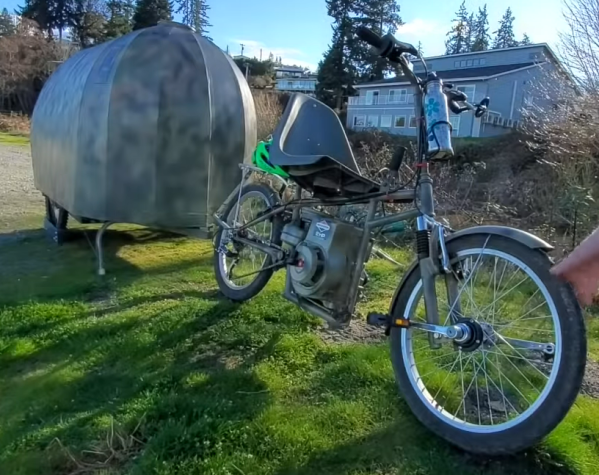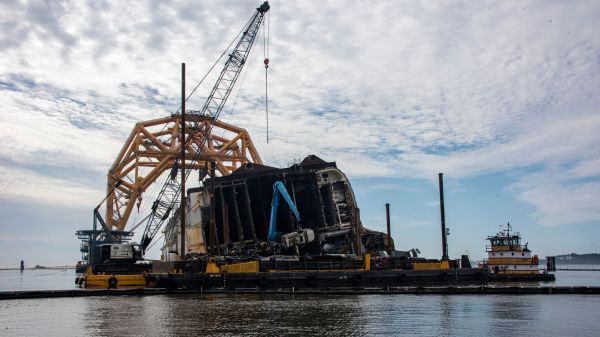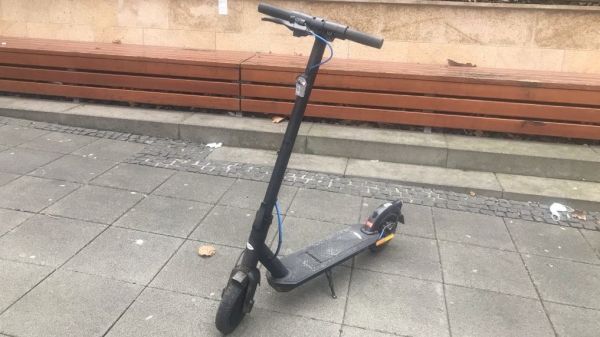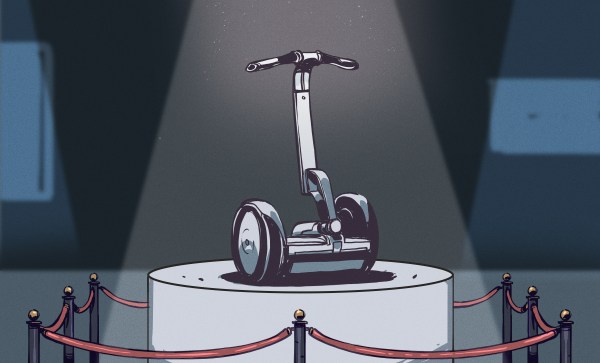Toyota is going through a bit of a Kodak moment right now, being that like the film giant they absolutely blundered the adoption of a revolutionary technology. In Kodak’s case it was the adoption of the digital camera which they nearly completely ignored; Toyota is now becoming similarly infamous for refusing to take part in the electric car boom, instead placing all of their faith in hybrid drivetrains and hydrogen fuel cell technologies. Whether or not Toyota can wake up in time to avoid a complete Kodak-style collapse remains to be seen, but they have been making some amazing claims about battery technology that is at least raising some eyebrows. Continue reading “Toyota Makes Grand Promises On Battery Tech”
transportation28 Articles
Snow Plowing By Bicycle
There are few challenges more difficult or dangerous than trying to get around the majority of North American cities by bicycle. Not only is the bicycle infrastructure woefully inadequate for safe travel (if it exists at all), but it’s often not maintained to any reasonable standard, either. This goes double in colder areas, where bike paths can essentially become abandoned in the winter after a snowfall. [Phil] found himself in this situation recently after a snowfall in western Canada and decided to DIY his own bike-powered snowplow to help keep his bike paths cleared.
The plow is built around an electric-assisted cargo bicycle, which is almost as rare in North America as bicycle infrastructure itself, but is uniquely suited to snowplow duty. It has a long wheelbase and a large front cargo area that can be weighed down if needed to ensure the plow makes good contact with the ground. The plow itself is built out of sections of plastic 55-gallon drums, which have been cut into two scooping sections and attached to the bike with a wooden 2×4 frame. The plow can be raised or lowered with a ratchet strap mechanism, and the plastic scoop skips over bumps in the path with relative ease.
With this relatively simple mechanism attached to his bike, [Phil] can make sure the trails that he frequents around Vancouver are more suitable for bike travel in the winter. Riding a bicycle through the winter, even in the coldest of climates, is not that difficult with the right support and investment in infrastructure, and this build is the best DIY solution we’ve seen to bicycle infrastructure support outside of adopting something like this remote-controlled snowblower to the job.
Bike On Over To The Campground
Like many of us, [Paul] enjoys occasionally hitching up his tow-behind camper and heading out to the wilderness to get away from it all at his favorite campsite. Unlike the vast majority of those who share his passion for the outdoors, though, [Paul] is hitching his camper up to a bicycle. Both the camper and the bike are custom built from the ground up, and this video shows us a little more details on [Paul]’s preferred mode of transportation.
While he is known for building custom vehicles of one sort or another, this latest one is a more traditional bicycle frame that he has modified only slightly to fit a recumbent-style seat and a small gas-powered motor. Even though the motor is decades old, it started right up and gives the power needed to pull the custom camper. [Paul] builds one-person campers like this out of corrugated plastic for durability and light weight, and this one is specifically designed for his size and sleeping style. It includes everything needed for a night under the stars, too, including a stove, storage compartments, and a few windows.
With the bike and camper combined weighing in at just over 200 pounds, the motor can be used as a pedal-assist device thanks to the clever engineering behind a front-wheel-drive pedal system on this bike. With all of that custom fabrication, [Paul] is free to head out to the wilderness without all the encumbrances (and high price) of traditional motor vehicle-based camping. For those curious about some of [Paul]’s other vehicle creations, take a look at this tiny speedboat for one.
A Big Ship Chop Shop On The Georgia Coast
Last week we saw a hapless container ship vaulted to fame, where people converged on its combination of mind-boggling size suffering an easily relatable problem of getting stuck. Now that it is moving again, armchair engineers who crave more big ship problem-solving should check out [David Tracy]’s writeup on the salvage operation of an overturned car carrier ship, the MV Golden Ray published by Jalopnik. If the ship’s name doesn’t ring a bell, the writeup opens with a quick recap.
Written for an audience of gearheads, [Tracy]’s writeup walks through some technical aspects of the salvage plan and initial results of execution. Citing from the official entity in charge, the St. Simons Sound Incident Response Unified Command, and augmented with information from elsewhere. Even though the MV Golden Ray is “only’ half the length and a third of the gross tonnage of our meme darling MV Ever Given, it is still a huge ship. Every salvage operation this big is unique, requiring knowledge far beyond our everyday intuition. At this scale, most Internet “Why don’t they just…” comments range from impractical to absurd.
Fortunately, people who actually know how to perform salvage work designed plans, submitted by multiple bidders, each making a different tradeoff in cost and speed among other factors. The chosen plan was to cut the ship into sections small enough to be carried by barge for further processing elsewhere. This required a huge floating crane, a chain pressed into cutter duty, custom fabricated lugs for lifting, and similarly custom fabricated cradles for the barges.
But we all know that no plan survives contact with reality. While this plan was seemingly chosen for speed, it hasn’t gone nearly as fast as advertised. Certainly the pandemic was a huge hinderance, but cutting has also been slowed by pieces built far stronger than spec. Delays also meant more sediment buildup inside the wreck, compounding headaches. Other bidders have started saying that if their plan had been chosen the job would be done by now, but who’s to say their plan wouldn’t have encountered their own problems?
In time St. Simons Sound will be cleared as the Suez Canal has been. Results of their respective investigations should help make shipping safer, but salvage skills will still be needed in the future. At least this operation isn’t as controversial as trying to retrieve the radio room of RMS Titanic.
Put More Scoot In Yer Scooter
We have a scooter hack that is odd for a couple of reasons. First, the vehicle in question is a Doc Green EWA 6000, a German clone of a Xiaomi M365, so Country stereotypes be darned. Second, it is about increasing the performance, and when we think of scooters, we get hung up on scoot. The link between these peculiarities is the speed limiter Germany requires on all scooters, which the Chinese model lacks. Despite the law, [Nikolaj] wanted a higher top speed and Bluetooth connectivity. Wireless unlocks advanced features, like cruise control, which are absent in the stock model.
The mainboard is responsible for speed control, but that is merely a component, and you can find third-party replacements. [Nikolaj] found a new part with a German forum member’s help, then recorded his work in English for our sake. The speed boost is nice, but the Bluetooth functionality is a massive improvement by itself. If you live in an area where the law doesn’t allow this sort of thing, think before you upgrade. Aftermarket parts aren’t always drop-in replacements, and in this case, the controller and display needed some finessing to fit, so measure twice and buy once.
If tearing into a brand new scooter isn’t for you, consider breathing new life into a retiree, and don’t forget that stopping is the other half of the battle.
Live Map Of London Tube Created In PCB And Lights
If you’re a frequent traveler on a public transit system, it can be helpful to know when the trains or buses are arriving and if there are any delays. We might reach for a tablet to mount on the wall, but that relies on keeping the OS, the software, and its library dependancies up to date. For true reliability you’ll need to build directly in hardware, which is exactly what this map of the London tube system uses.
The base map is printed directly on PCB, with LEDs along each of the major routes to indicate the current location of the trains. A few small chips handle the WiFi connection — it appears to our eye to be an ESP8266 — and pulling the information about the trains from the London Underground API (it would be virtually impossible to build everything for this project in hardware). The hardware can be easily reprogrammed, and with the PCB layout this could be adapted for other public transit fairly easily.
Even apart from the philosophical differences on design between hardware and software approaches, we still appreciate the aesthetic of LEDs on PCB. In fact, we’ve seen a whole host of artwork on PCBs ever since the price came down dramatically in the past two decades.
Thanks to [Al] for the tip!
The Segway Is Dead, Long Live The Segway
Before it was officially unveiled in December 2001, the hype surrounding the Segway Human Transporter was incredible. But it wasn’t because people were excited to get their hands on the product, they just wanted to know what the thing was. Cryptic claims from inventor Dean Kamen that “Ginger” would revolutionize transportation and urban planning lead to wild speculation. When somebody says their new creation will make existing automobiles look like horse-drawn carriages in comparison, it’s hard not to get excited.
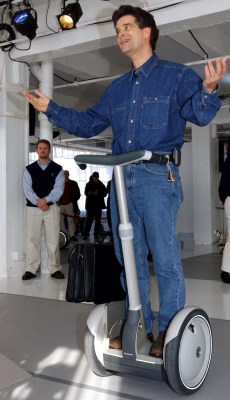
There were some pretty outlandish theories. Some believed that Kamen, a brilliant engineer and inventor by all accounts, had stumbled upon some kind of anti-gravity technology. The kids thought they would be zipping around on their own Back to the Future hover boards by Christmas, while Mom and Dad were wondering what the down payment on a floating minivan might be. Others thought the big secret was the discovery of teleportation, and that we were only a few years out from being able to “beam” ourselves around like Captain Kirk.
Even in hindsight, you really can’t blame them. Kamen had the sort of swagger and media presence that we today associate with Elon Musk. There was a general feeling that this charismatic maverick was about to do what the “Big Guys” couldn’t. Or even more tantalizing, what they wouldn’t do. After all, a technology which made the automobile obsolete would change the world. The very idea threatened a number of very big players, not least of which the incredibly powerful petroleum industry.
Of course, we all know what Dean Kamen actually showed off to the world that fateful day nearly 20 years ago. The two-wheeled scooter was admittedly an impressive piece of hardware, but it was hardly a threat to Detroit automakers. Even the horses were largely unconcerned, as you could buy an actual pony for less than what the Segway cost.
Now, with the announcement that Segway will stop production on their eponymous personal transporter in July, we can confidently say that history will look back on it as one of the most over-hyped pieces of technology ever created. But that’s not to say Kamen’s unique vehicle didn’t have an impact. Continue reading “The Segway Is Dead, Long Live The Segway”



